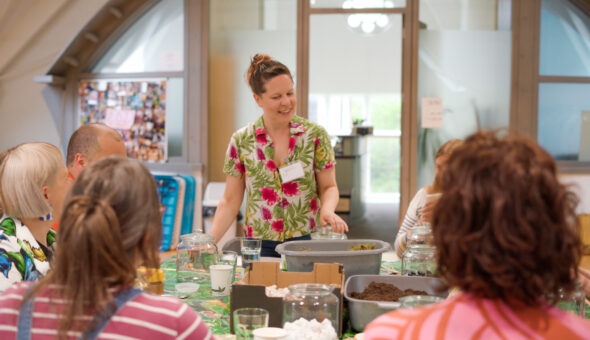This is the second entry of a blog series about embedding a positive culture of public engagement at NAM 2020. Read the first entry here.
To date, most of the work that has been done to embed public engagement in research culture has taken place in institutions such as universities and research centres. Conferences, occurring over the course of a week, or few days and featuring researchers from all over the country/world, present an environment with a distinctive set of characteristics that can be quite different to those of an institution. These differences will play an important role in how the Public Engagement Unit approaches our work to help embed public engagement in the National Astronomy Meeting (NAM) 2020.
Institutions vs Conferences
As a sector, our learning, and most of the funding for embedding public engagement, comes from work done in universities and other research institutions rather than conferences so we need to be mindful of what might be different when applying our learning to a conference environment. We've done a bit of thinking to identify the five key differences between conferences and institutions:

What does this mean for our approach?
As a starting point, we wanted to interrogate what the differences were between conferences and institutions and what that means for our approach, this includes thinking about:
Duration
Conferences are short-lived events; this puts some unavoidable constraints on what we can and can’t do. We can’t, for example, host a weeklong training course or a funding call which stays open for a month. Delegates are more time limited at conferences and will have conference sessions, social activities and public engagement activities vying for their time throughout the event. We need to be careful not to overburden delegates with too many opportunities, but also provide a diversity of activities that can interest delegates from a wide range of backgrounds and skill levels.
Purpose of conferences
What do delegates expect from a conference? We know one of the main purposes for researchers attending conferences is to share knowledge and build partnerships and with that in mind our approach should put these needs first. With this in mind, we will be supporting conference sessions sharing engagement practice helping to make these sessions valuable learning experiences, providing opportunities for delegates to meet and learn from each other and providing training opportunities based on areas the community of researchers have identified as a need. In this way we can move with the grain of conference culture, rather than fighting against it, which was a key piece of learning from embedding public engagement at the University of Bath.
Disciplinary practice
Conferences like NAM are single discipline. At the University of Bath, we are used to working across all of our faculties and schools and dealing with a variety of different departmental cultures. What does this difference mean for our practice?
At NAM we are only working with one subject area (astronomy) which gives us the opportunity to think about what specific kinds of public engagement and engagement training might be most relevant to astronomers. We know the Royal Astronomical Society has previously funded artists to create works inspired by astronomy so we will provide opportunities for delegates to engage with artists and create art based on their research. In addition, we will be showcasing specific engagement projects from astronomy which will be more relevant to delegates than examples from another disciplines and provide training opportunities that best suit astronomy as a discipline. Identifying some of these projects and training opportunities will be an important next step that will involve us working with members of the NAM community.
Defining our boundaries
Alongside events for delegates, conferences also have public-facing programmes which can include public talks, events and press coverage. In supporting researchers at NAM to engage with public groups some of our events such as Science Showoff or Walking With Scientists will become part of the public programme. However, we have to carefully define our boundaries here and be sure we aren't taking responsibility for the broader public programming of NAM as this doesn't fit our brief of embedding public engagement within an academic conference. Recognising this, it's important to make sure all of the stakeholders we work with are aware of our boundaries and what we can and can't help with.
This is similar to how we define our boundaries in respect to the University of Bath. As the Public Engagement Unit we support researchers to engage with public groups, but we don't actually do any public engagement ourselves and we don't support events that are public facing without featuring two way engagement with research. In this way defining our boundaries at NAM is similar to how we have defined our boundaries within our institution.
Our next step in the process is to work with our key allies throughout the NAM community and the University to put in place opportunities for delegates to get involved in public engagement, learn about engagement and celebrate the work they have done. To do this we need to understand the community and provide opportunities that are relevant to them in the context of NAM. We also aim to include these opportunities in the conference infrastructure by looking for expressions of interest in the registration form. This allows us to identify how many delegates are interested in certain activities and allows us to follow up with these groups and provide further information and support for their engagement work.
Rob Cooper is a Public Engagement Officer at the University of Bath
Respond



